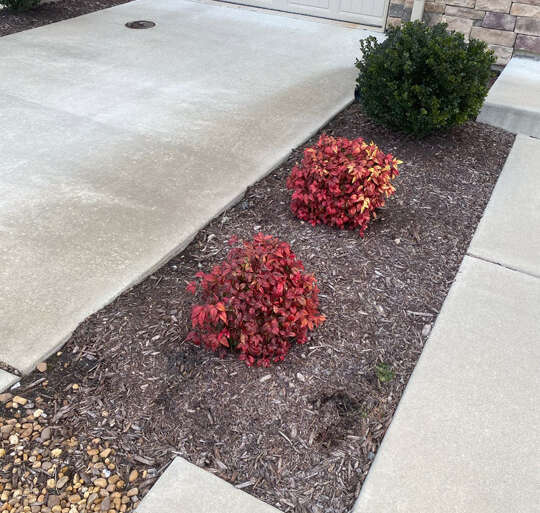Winter can be a challenging time for lawn care and landscaping, especially if you live where it frosts and snows. While your yard and landscaping don’t always need the same level of attention in the winter, preparing your lawn for the winter is crucial to having a good spring and summer. Use these winter lawn care tips to ensure you are setting your landscaping up for success when the weather warms up and maintaining it during the cold weather.
Winter Lawn & Landscape Preparation
The first step to ensuring landscaping success year-round is to prepare your lawn and landscape accordingly. Preparation should start in September ideally, but anytime before the first frost is really when it matters the most.
Rake Leaves
Before the bad weather hits, rake leaves away and clear any brush off the lawn. Leaving this on your lawn, especially after the weather gets cold, can lead to dead spots when the snow and ice melt away. If the leaves are not too thick and damp, you can mulch them instead of raking and removing them.
Aerate the Grass for Fertilization
Giving your grass and lawn the chance the breath before the first frost is important. During the winter, the grass goes dormant so aerating right before gives additional room for the roots to grow so that when springtime rolls around, your lawn doesn’t thin out from weak or brittle roots and relieves any compaction in the soil. Winter grass care and aeration is especially important if your lawn:
- Gets heavy foot traffic
- Was recently established as part of a new-build
- Dries out easily or has excessive thatch
- Was created from sod or has soil layering
Winter Lawn Fertilization
 The next, natural step to winter lawn preparation after aeration is fertilizing. Aerating gives fertilizer direct access to the roots of the grass. Fertilizer gives the grass the nutrients it needs to remain strong and grow. Once spring hits, the grass uses the nutrients from the fertilizer to get a head start on the season. Using the right fertilizer before winter hits can have your grass looking greener than the neighbor’s when the snow starts to melt. The fertilizer will also help prevent weeds from growing and pests from making a new home in your lawn.
The next, natural step to winter lawn preparation after aeration is fertilizing. Aerating gives fertilizer direct access to the roots of the grass. Fertilizer gives the grass the nutrients it needs to remain strong and grow. Once spring hits, the grass uses the nutrients from the fertilizer to get a head start on the season. Using the right fertilizer before winter hits can have your grass looking greener than the neighbor’s when the snow starts to melt. The fertilizer will also help prevent weeds from growing and pests from making a new home in your lawn.
Covering Trees
If you have thin-barked or young trees placed in sunny areas, it’s a good idea to wrap their bark in lightly colored wrapping to prevent frost and sun-scald.
Winterize Sprinkler System
The last thing you want to deal with in the spring is a huge bill to fix your sprinkler system because it wasn’t winterized before the cold weather hits. By failing to prepare your sprinkler system for the winter, you risk bursting pipes when the water expands inside due to the cold weather.
Landscaping and Winter Lawn Maintenance
When your lawn and landscaping have been prepared properly, there are still things you can do to maintain it during the winter and ensure a seamless spring.
Avoid Lawn Traffic
The frost and cold weather can make your grass frail and brittle, and if the lawn gets heavy foot traffic, this can further break down the grass. If possible, do not allow heavy foot traffic, especially in the same areas over and over as this will increase the chances of breakage. One of the best ways to prevent people from using the grass over walkways is to keep them shoveled and salted when the bad weather hits. People like to walk on the grass as a way to prevent slipping and falling, which won’t be an issue if the designated walkways are clear.
Protect Landscaping Near Road Salt
Keeping walkways salted is important, but it’s also important to protect landscaping from excessive exposure to salt. If you have bushes, shrubs, hedges or a lawn near a major roadway or high-traffic area that will experience a lot of road salt during the winter months, consider covering them. Avoid excess salting of close areas when possible.
Continue Raking
If its a dry winter or you don’t get a lot of snow, raking can be part of your winter lawn maintenance.
It may not be needed once all the leaves have fallen, but if a need arises, continue raking even if you’ve already said to yourself, “This is my last rake of the year.” Avoiding piles of leaves and brush will prevent mold and fungus growth when it gets wet and cold.
Mowing During the Winter
Mowing into the winter depends on when your grass stops growing. Depending on where you are and what your climate and weather are like, you may need to continue mowing, albeit less frequently, so long as the grass continues to grow. Once it has stopped growing, you can stop mowing for the season. It’s common to mow the grass shorter and shorter as you get closer to the cold weather, but reserve changing the height on your mower blade until the last mow of the season. However, do not mow too short otherwise you are opening the doors to weeds and diseases.
Watering Plants and Shrubs
The need for watering plants and shrubs does not go away just because it is cold and possibly snowy. Not maintaining watering on fruit trees, hedges, shrubbery and lawn when snow isn’t present can leave them susceptible to disease and a wide range of other issues.
Lawn Care and Landscaping Services for the Winter
No matter the property type or size, it’s important to use these winter lawn care tips to gear up for spring. Whether you are preparing preparing your residential landscaping for winter or getting your commercial property ready, BCLS Landscape Services can help. Discover the greener side of life and contact an expert with BCLS Landscape Services today.



